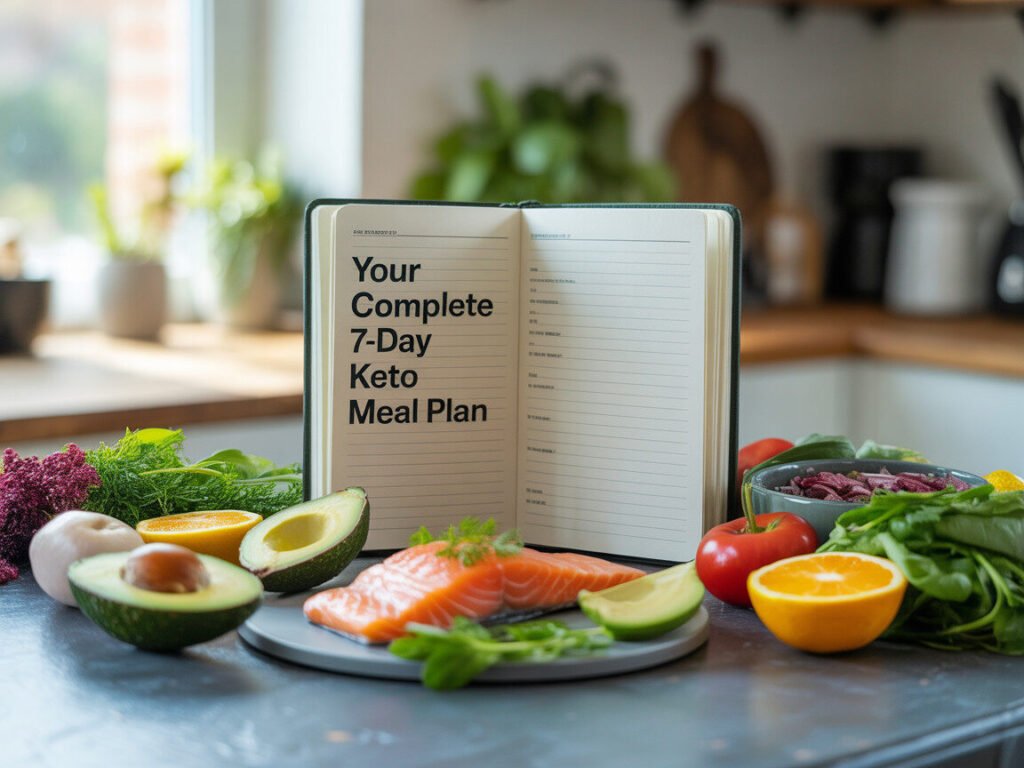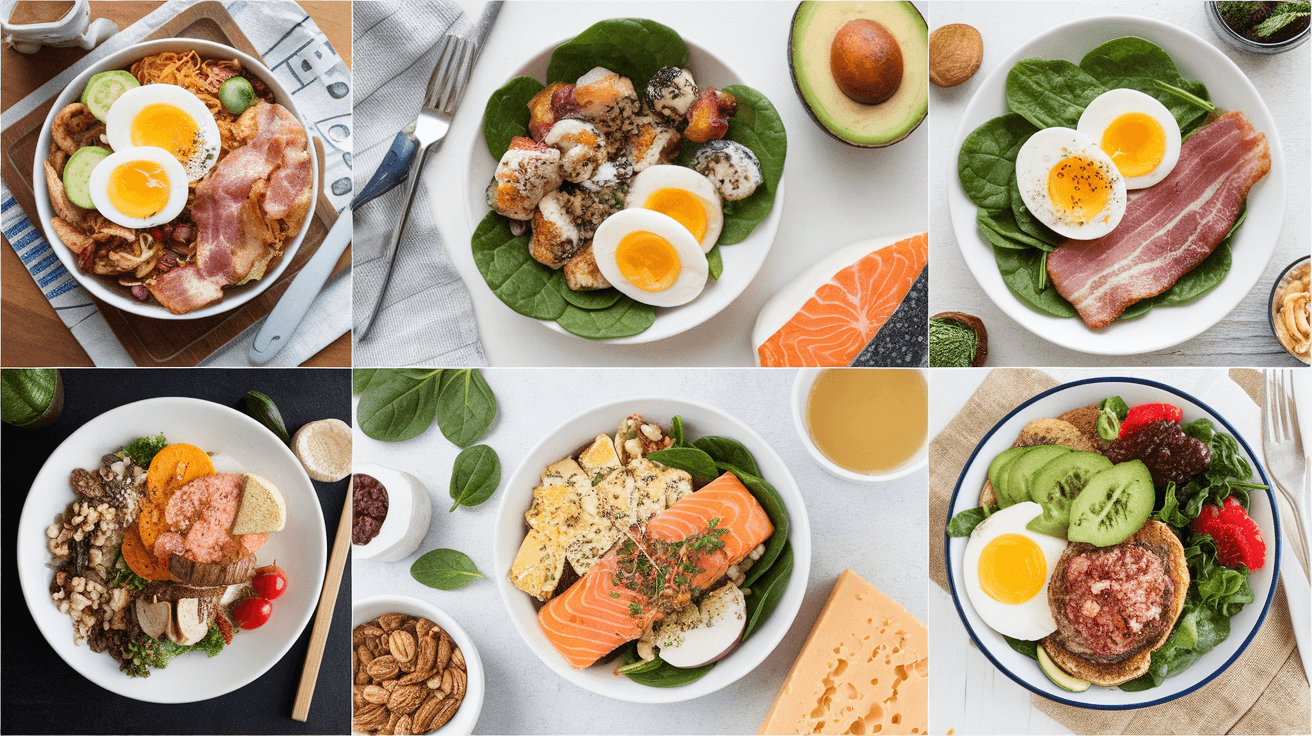Starting a ketogenic diet can feel overwhelming, especially when you’re bombarded with conflicting information about what to eat, when to eat it, and how to avoid the dreaded “keto flu.” The good news is that with a well-structured 7-day keto diet plan, you can transition smoothly into ketosis while enjoying delicious, satisfying meals that support your weight loss goals.
This comprehensive guide provides everything you need for your first week on keto, including detailed meal plans, shopping lists, meal prep strategies, and expert tips to help you succeed. Whether you’re looking to lose weight, improve your energy levels, or simply adopt a healthier lifestyle, this beginner-friendly approach will set you up for long-term success.
Understanding the Ketogenic Diet: Your Foundation for Success
The ketogenic diet is a high-fat, moderate-protein, low-carbohydrate eating plan that shifts your body’s primary fuel source from glucose to ketones. When you drastically reduce your carbohydrate intake to typically 20-50 grams per day, your liver begins converting stored fat into ketones, a process called ketosis.
Research published in the Journal of Clinical Medicine demonstrates that ketogenic diets can lead to significant weight loss, improved insulin sensitivity, and enhanced cognitive function. The diet typically consists of approximately 70-75% fat, 20-25% protein, and 5-10% carbohydrates.
Understanding these macronutrient ratios is crucial for your success during the first week. Many beginners struggle because they don’t consume enough fat or accidentally exceed their carbohydrate limits. The key is focusing on whole, nutrient-dense foods while maintaining the proper macronutrient balance.
What to Expect During Your First Week on Keto
Your first week on the ketogenic diet is a period of significant metabolic adaptation. During days 1-3, your body will deplete its glycogen stores, which can lead to rapid initial weight loss of 2-5 pounds. However, much of this initial loss is water weight, not fat.
Between days 3-7, many people experience what’s commonly called the “keto flu.” Symptoms may include fatigue, headaches, irritability, and difficulty concentrating. These symptoms occur because your body is learning to efficiently use ketones for fuel instead of glucose. According to research from the American Journal of Clinical Nutrition, these symptoms typically resolve within a week as your body becomes keto-adapted.
To minimize these side effects, focus on staying hydrated, maintaining adequate electrolyte levels, and getting sufficient sleep. Many people find that increasing their sodium intake through bone broth or adding a pinch of high-quality sea salt to their water helps alleviate symptoms.
Essential Foods for Your 7-Day Keto Journey
Building your meals around the right foods is fundamental to keto success. Your grocery list should emphasize high-quality fats, moderate amounts of protein, and very low-carbohydrate vegetables.
Healthy Fats (70-75% of calories): Avocados, olive oil, coconut oil, grass-fed butter, nuts, seeds, and fatty fish like salmon and mackerel should form the foundation of your meals. These foods provide sustained energy and help you feel satisfied between meals.
Quality Proteins (20-25% of calories): Choose grass-fed beef, free-range poultry, wild-caught fish, eggs, and full-fat dairy products. Protein is essential for maintaining muscle mass during weight loss and supporting metabolic function.
Low-Carb Vegetables (5-10% of calories): Leafy greens, broccoli, cauliflower, zucchini, bell peppers, and asparagus provide essential nutrients and fiber while keeping carbohydrate intake minimal. These vegetables also add volume and variety to your meals without compromising ketosis.
Your Complete 7-Day Keto Meal Plan

Day 1: Easing Into Ketosis
Breakfast: Avocado and spinach omelet cooked in grass-fed butter (3 eggs, 1/2 avocado, 1 cup spinach, 1 tablespoon butter)
- Macros: 28g fat, 20g protein, 4g net carbs
Lunch: Grilled chicken salad with olive oil dressing (4 oz chicken breast, mixed greens, cucumber, cherry tomatoes, 2 tablespoons olive oil)
- Macros: 32g fat, 35g protein, 6g net carbs
Dinner: Baked salmon with roasted broccoli (5 oz salmon, 1 cup broccoli, 1 tablespoon coconut oil)
- Macros: 35g fat, 40g protein, 5g net carbs
Daily Totals: 95g fat, 95g protein, 15g net carbs
Day 2: Building Momentum
Breakfast: Keto coffee with MCT oil and full-fat Greek yogurt with berries (1 cup coffee, 1 tablespoon MCT oil, 1 tablespoon heavy cream, 1/2 cup Greek yogurt, 1/4 cup blackberries)
- Macros: 25g fat, 15g protein, 8g net carbs
Lunch: Tuna salad lettuce wraps (1 can tuna, 2 tablespoons mayonnaise, celery, wrapped in butter lettuce)
- Macros: 28g fat, 25g protein, 4g net carbs
Dinner: Grass-fed beef stir-fry with low-carb vegetables (5 oz ground beef, bell peppers, zucchini, onions, cooked in avocado oil)
- Macros: 40g fat, 35g protein, 8g net carbs
Daily Totals: 93g fat, 75g protein, 20g net carbs
Days 3-7: Maintaining Consistency
Continue following similar meal patterns, rotating proteins and vegetables to maintain variety while staying within your macronutrient targets. Focus on meal prep strategies to ensure you always have keto-friendly options available.
Keto Meal Prep Strategies for Busy Beginners
Successful meal preparation is often the difference between keto success and failure, especially during your crucial first week. Studies in the International Journal of Behavioral Nutrition show that people who meal prep are more likely to stick to their dietary goals and achieve better health outcomes.
Start by dedicating 2-3 hours on Sunday to prepare proteins in bulk. Cook several chicken breasts, brown ground beef, and hard-boil a dozen eggs. These protein sources can be quickly combined with pre-cut vegetables and healthy fats throughout the week.
Prepare grab-and-go fat bombs using coconut oil, nut butter, and sugar-free sweeteners. These portable snacks help you meet your fat macros when hunger strikes between meals. Store them in the refrigerator for up to a week.
Pre-wash and chop low-carb vegetables like broccoli, cauliflower, bell peppers, and zucchini. Having these ready makes it easy to add volume and nutrients to any meal. Consider roasting a large batch of mixed vegetables with olive oil and herbs for easy reheating throughout the week.
Managing Keto Flu and Side Effects
The transition period can be challenging, but understanding how to manage potential side effects will help you push through to the benefits on the other side. Electrolyte imbalance is the primary culprit behind most keto flu symptoms.
Sodium needs increase significantly on a ketogenic diet because reduced insulin levels cause your kidneys to excrete more sodium. Aim for 3,000-5,000mg of sodium daily through natural sources like bone broth, sea salt, and naturally cured meats. This is significantly higher than standard dietary recommendations but necessary for keto adaptation.
Magnesium deficiency can cause muscle cramps, sleep issues, and fatigue. Supplement with 300-400mg of magnesium glycinate daily, or increase consumption of magnesium-rich foods like spinach, pumpkin seeds, and dark chocolate (85% cacao or higher).
Potassium supports proper muscle and nerve function. While supplements are limited to 99mg due to regulations, you can increase intake through avocados, spinach, and salmon. Many people find that a combination of proper electrolyte management and gradual carbohydrate reduction minimizes side effects.
Tracking Progress and Staying Motivated
Monitoring your progress during the first week helps maintain motivation and allows you to make necessary adjustments. Weight loss during the first week can be dramatic but remember that much of this is water weight as your body depletes glycogen stores.
Focus on non-scale victories like improved energy levels, better sleep quality, reduced cravings, and enhanced mental clarity. Many people report these benefits within the first 3-5 days, even before significant weight loss occurs.
Consider tracking ketone levels using urine strips, blood meters, or breath analyzers. While not necessary for success, seeing measurable ketosis can provide motivation and confirm you’re on the right track. Blood ketone levels between 0.5-3.0 mmol/L indicate nutritional ketosis.
Take body measurements and progress photos rather than relying solely on the scale. Research from the American Journal of Preventive Medicine shows that people who track multiple metrics are more successful at maintaining long-term weight loss.
Common Mistakes to Avoid During Your First Week
New keto dieters often make predictable mistakes that can derail their progress or make the transition more difficult than necessary. Learning from others’ experiences can help you avoid these pitfalls.
One of the most common mistakes is not eating enough fat. Many people have been conditioned to fear dietary fat, but on keto, fat is your primary fuel source. If you’re feeling hungry, tired, or unsatisfied, you likely need to increase your fat intake rather than restrict calories.
Another frequent error is consuming hidden carbohydrates in processed foods, condiments, and restaurant meals. Always read nutrition labels carefully and be aware that ingredients like maltodextrin, dextrose, and modified food starch can kick you out of ketosis even in small amounts.
Inadequate hydration compounds electrolyte imbalances and worsens keto flu symptoms. Aim for at least half your body weight in ounces of water daily, plus additional fluids if you’re active or live in a hot climate.
Building Long-Term Success Beyond Week One
While this 7-day plan provides an excellent foundation, sustainable success requires developing habits and strategies that extend well beyond your first week. The goal is to create a lifestyle that feels natural and enjoyable rather than restrictive.
Focus on developing a repertoire of go-to meals that you genuinely enjoy and can prepare quickly. Having 10-15 reliable recipes prevents boredom and reduces the temptation to deviate from your plan when life gets busy.
Consider the social aspects of eating and plan strategies for dining out, attending social events, and handling peer pressure. Most restaurants can accommodate keto requests with simple modifications like substituting vegetables for starches and asking for sauces on the side.
Experiment with different approaches within the ketogenic framework to find what works best for your lifestyle. Some people thrive on strict macronutrient tracking, while others prefer a more intuitive approach focusing on food quality and hunger cues.
Frequently Asked Questions
Q: How quickly will I see weight loss results on a 7-day keto diet plan? A: Most people see initial weight loss of 2-5 pounds during the first week, primarily from water weight as glycogen stores deplete. Fat loss typically becomes more apparent in weeks 2-4 as your body becomes fully keto-adapted.
Q: Can I exercise during my first week on keto? A: Light to moderate exercise is fine, but avoid intense workouts during the first week as your energy levels may be lower during the adaptation period. Focus on walking, gentle yoga, or light resistance training until you feel more energetic.
Q: What should I do if I accidentally eat too many carbs? A: Don’t panic or abandon your plan. Simply return to your regular keto meals at the next opportunity. One high-carb meal won’t undo your progress, but consistency is key for maintaining ketosis.
Q: Is the keto diet safe for everyone? A: While generally safe for healthy individuals, people with certain medical conditions, pregnant or breastfeeding women, and those taking medications should consult with a healthcare provider before starting any new diet plan.
Q: How do I know if I’m in ketosis? A: Common signs include reduced appetite, increased energy after the adaptation period, metallic taste or fruity breath, and measurable ketones in blood, urine, or breath. However, these signs aren’t necessary for success.
Starting your ketogenic journey with a structured 7-day plan sets the foundation for long-term success. Remember that the first week is about adaptation and learning, not perfection. Focus on making sustainable changes, listen to your body, and celebrate the small victories along the way. With consistency and patience, you’ll soon experience the energy, mental clarity, and weight loss benefits that make the ketogenic lifestyle so rewarding.
